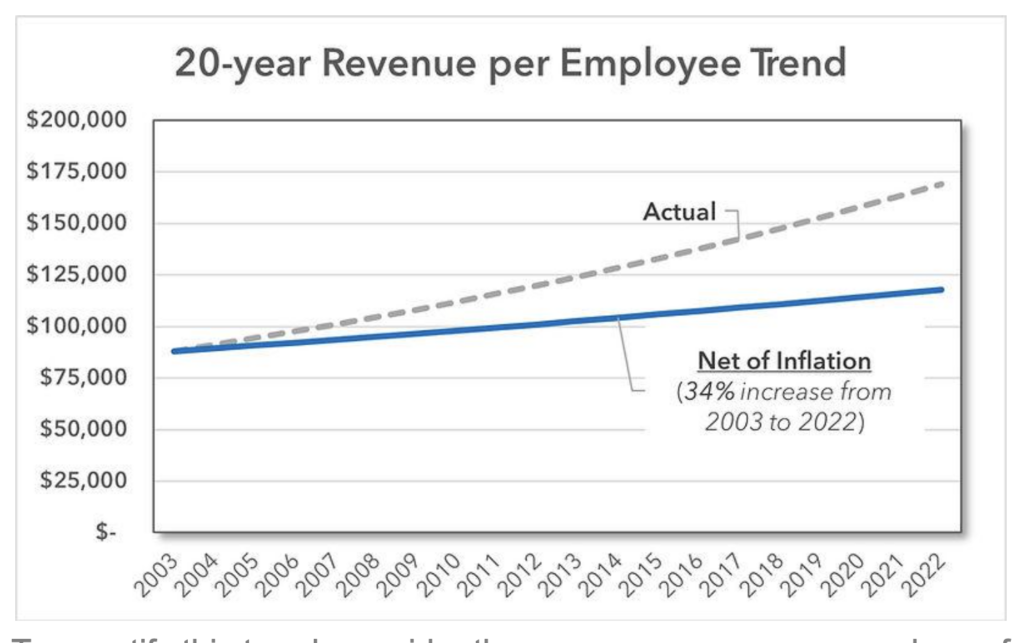A review of recent trends in the architecture and engineering industry reveals the skills firms need to succeed as the industry evolves from measuring employee count to managing employee revenue and profit.
In the early ‘90s offices were full of green drafting boards and “high-tech” electric erasers. Teams of designers and engineers spent each day producing mylar drawings. After a brief learning curve each designer could produce about the same number of hand-drawn documents on a daily basis. As such, a company’s production could be measured by the size of its workforce, as it had been for generations.
Managing this operation was relatively straightforward. To produce twice as many documents a company needed to double its production staff. The advent of CAD, design software, collaboration systems, spreadsheets, database management, etc. has slowly converted the simple operation into a dynamic process. Defining a firm by the number of employees has become an ambiguous and outdated label, with the industry favoring measurement of firm size by annual revenue.

The roles and responsibilities for production employees from designer to engineer have become significantly more dynamic. From learning CAD to adopting BIM to cloud-based collaboration, the designer skillset has evolved tremendously. Engineers are challenged to become familiar with the designer skillset, leverage a host of software programs and gain familiarity with technical codes as well as social design considerations like LEED or WELL standards. Each new advancement adds a wrinkle to the design process. Now, more than ever, management and leadership skills in the AE industry are at the forefront of production. Below are four examples of how management skills are a deciding factor in the success of a consulting firm.
Building A Scalable Production Process
The standard process for production 30 years ago was relatively simple and fit on one sheet of paper. Designers today are faced with a variety of computer software tools. Engineers and architects now consider the need for LEED, WELL, energy codes, carbon footprints, etc. The design process routinely changes and keeping up with these changes requires internal collaboration, industry research and leadership. The only way to stay on top of the issues is investing in non-billable hours. Non-billable hours were once taboo in the industry. But the correct way to view non-billable hours is an investment with an expected return. This is likely a contributing factor to the historical decline in firm utilization. More time is invested in planning the design process which is contributing to the revenue per employee increase.
Overseeing Employee Development
“I don’t waste a lot of time training my staff, because I want them to learn from their mistakes, just like I did.” That statement was made by a partner in an owners’ meeting just 10 years ago. Needless to say, full-scale employee training is relatively new in our industry and subsequently there is not a definitive standard. But if firms are able to recognize the need, structure a program and manage the process, it will pay great dividends. Implementing a mentorship program is a simple and effective way to start.
Managing Technology
“Firms need to rethink – and ultimately redefine – what it means to be a CIO. It is a strategically critical role that needs to have the human, institutional and political capital to make decisions and affect change. This requires a commitment to investing both human and financial resources, and the tone needs to be set at the top.” – Daphne Bryant, Executive Director, American Council of Engineering Companies
As noted, firms are historically reluctant to spend non-billable hours. Overcoming this hesitation and realizing the investment in time to research technology has a substantial return is a significant step towards leveraging the appropriate management skills to grow a firm’s revenue.
Elevating Project Management
According to the Project Management Institute (PMI) 61% of firms provide some form of project management training. And more specifically in the AE industry a Deltek survey reports that 49% of the responding firms planned to invest in internal project management training in the near future. This training investment is likely to have the greatest ROI of any of the employee programs, since the project management process has the greatest impact on revenue generation. Training systems can be developed with the format from a third-party provider, customized it the company’s brand, and simplified it to align with the customer base and values. As the company grows and expands into different regions the documented process can become invaluable to maintaining consistency and optimizing operations.
It is not clear if the majority of firms realize the revenue per employee trend, and are actively integrating it into their business model. But it is becoming increasingly clear increasing revenue per employee relies heavily upon a firm’s management and leadership skills.

